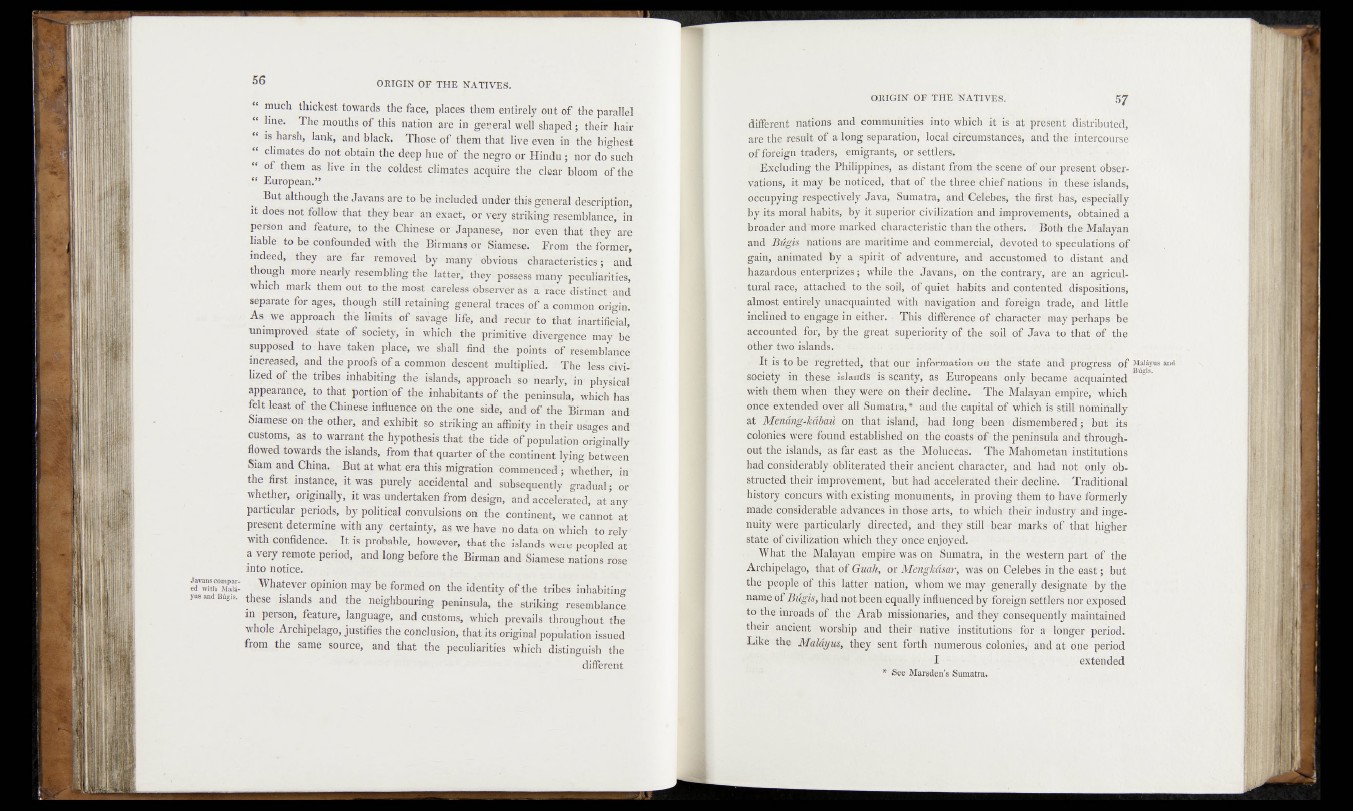
Javans compar
ed with Mala
ju s and Bügis.
“ much thickest towards the face, places them entirely out of the parallel
“ line. The mouths of this nation are in general well shaped; their hair
I isharsh> lank> and black. Those of them that live evéri in the highèst
” ckmates do not obtain the deep hue of the negro or Hindu ; nor do such
of them as live in the coldest climates acquire the clear bloom of the
“ European.”
But although the Javans are to be included under this general description,
it does not follow that they bear ah exact, or very striking resemblance/in
person and feature, to the Chinese 01-' Japanese* norihv'én' /that they-'hre
liable to bë coiifbmrdM' with the Birmans or Siamese. From thé former,
indeed, they a r e ’far removed" by many' obvious -èlmtadteristics • and -
though more nearly resembling the ktte r^ th ey possess many Peculiarities,
which mark them out to the most careless-óbserver as’ a race^'tffiet^aijd
separate for ages, though still retaining general traces of a commori'brigin.
As, we approach the limits of savage life, and rechr "'to that maftifihiÖ,
unimproved state iof,society, in which the primitive divergence may 'be4
supposed to have taken place, we shall find the - pdints of-resemblance'
increased, and-the-proofs of a common descent multiplied. '<THCf^l,egs»‘civid
lized of the tribes inhabiting the islands, approach.so nearly, iC'-physiêaT
appearance, to that portion'of the inhabitants of the penmsula^whfch-'ha^
feltleast ofthe.ehinese;influence on the one sidè, and-of the -Birman-and-
Siamese on the other,, and exhibit so striking an affinity imtheiEüsagësind'
customs, as_vto warrant the hypothesis that the fide of population originally
flpwed towards the islands, from that, quarter of.the ^ontinèht-lying>tetWefen'
Siam and China. But at what era this migration'commenced:; whether,;:iri’
the first instance, it was purely' accidental and subsequently gradual;-or'
whether, originally, it was undertaken from design, and acceM-ate^-ait any
particular periods, by political convulsions oii the continent, we canndt- at1
present determine with any certainty, as we have mo, data on’which-totrlly’
with confidence. It is probable,, however, that the islands were peopled a t!
a very remote period, and long before-.tbe Birman and-Siamese nations tflsC
into notice.
Whatever opinion may be formed on the identity of the tribes; inhabiting ■
th ^e islands and -:#mneighbouringpeninsula, the striking resemblance
in person, feature, language, and fcustqms,. which prevails throughout the
whole Archipelago, justifies the conclusion, that.its original population issued
from the same source, and that the peculiarities which distinguish the
different
different nations and comifiuriiffës-- into which ii4s -at- pres’ent distributed,1
ar#firdSr.esult of along^separatiori, local circumstances/ and-the» intercourse
o f foreign baders, -emigrant^),dr-‘§etflëfrsW^
1 -'Excluding the'Fhilippines, as distant fnoin.the-sceneQfdur'present'obser-
vatróns, -it'may be-ph^e'd, that-of the tqrëê'chief nations* ih' éHéS^islandsi
'.^ffciïpying'reSpeictivelyJkva, sSutaatra,- and? Celebes^ the’ fitst - has, especially
by 'its1 motlf habits/ by ‘it-superior civiliza!fi(^^fid^imprfeyénïehts, -obt'ainéd' a
broader and^giore -in&rke'A characteristic than; thefotfers. -f BothHh e;Malayan
and Bugis fixations are maritime kndpcommereial-/ de^dfedstotspeculai^^W
gain/tanimated <by-a 'spirit- of-adventure; and'-accustomedttfo - distant arid
hazardousienterprizfes; while-the JaVan^on-the'qonfraïyj^are^n- agricultural
rae;ë,: attadhêcMténiSèlNeill -óf-(^Éieë ^habits;and-'conferithd/dispositions}
almost Entirely uriaéqu&’iifted withonavjgation and' foidi^n, tWde, and little
iriclihedtoverigige, ibufeithér.L- - This^dMFefené'e': df^ctfaFactér' may perhaps /Be
acc,ountedNfor?'* ^ ^ h e ‘ great superiority,of the spjh of »Java tq:Jt$i& of -the
other’two' islan d ^ fej
beivbgr'efctëd1, that our^iofosmalcoa-on ■ the". staté^pdr progress of'
hfqjefy'sin thbsfe islands "is^qafity, as Europeans*o^^J5d^Anhj'afeijuainted
witkH-hetn .whên^tBey' were on^beif kholine. -The ’ Mal^yaM ‘empire,n which
oncyéxteridéd-my^valli Sumatra, a'fid?the capital-of;whieBfJs:sfiU|hbmirialiy'
,&&ÈIênÉngr]$dbaü on1 that island, had longrbeen disfriérnbered-; -But .its
colqMfesT^^^fsund established1 ori^-the ^oatt-^bf^-the^penin^^fld^thwfe^
qi^th^ilMfd^'lsfar east asflne Moluccas. KTh’e Mahometan^ in'stitüfiöns
hadfgpÈ^idërab^bblitêrated their ancMd^qhhracW/farid -»had Mafci'bnly- obstructed
their improvement, but had-accelerated ^Hbir^dèclirié. - Traditional
histöfypbnqurs'with existing .monuments,'-'in- proving-tftëïmtb hafed formerly
madd'-cö’röëdë'rable advances in thosfe' 'a'r-ts, to-'Which* j^irripduk’ry anti-inge*
Rïïi,|ja|we]*e -particularly directed} and-: they still»,-bedr ^marks^ofi^tha^higher
stSlt'è^^ëivi 1 ization which ®èy önéêenjoyecL ■
< What-the» Malayan empire was’on-Sumatra, in the- western part inf - the
Archipelago/ that fl0 u a h , or .MeragMsar’-fw^ -the êa’stf*; t-bpf
the?rpê‘opleibï;this- latter nation, whom :welmay»>generally designate» >by the
name of Bugis, had not bëé'n equally influenced-by--fbreigri:setfier-s, hibriexposëd
to-tfeinroads of the'Arab-missionaries, arid:they consequeritly mairitairied
their -anGi'ênt^t'-worship and 'tïfêïr -' ft&tivip<|pns titutions- foiyfa longer' period!
Eike the: Malayu$,^a&y sent- f0ifthJm'un3^fdusU^oiflis/ 'and at- one period
I . - , . extended
* See Marsden’s Sumatra..
Malayus mid: ÜHHI ■